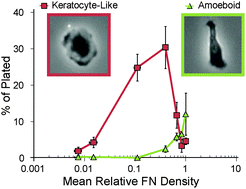Ligand density elicits a phenotypic switch in human neutrophils†
Abstract
Neutrophils are mediators of innate immunity and motility is critical to their function. We used microcontact printing to investigate the relationship between density of adhesive ligands and the dynamics of neutrophil motility. We show that neutrophils adopt a well-spread morphology without a uropod on moderate densities of adhesion ligand. As density is increased, the morphology switches to a classic amoeboid shape. In addition to the morphological differences, the dynamics of motility were quantitatively distinct. Well-spread cells without uropods glide slowly with high persistence, while amoeboid cells made frequent directional changes migrating quickly with low persistence. Using an antibody panel against various integrin chains, we show that adhesion and motility on fibronectin are mediated by MAC-1 (αMβ2). The phenotypic switch could be generalized to other surface ligands, such as bovine serum albumin, to which the promiscuous MAC-1 also binds. These results suggest that neutrophils are capable of displaying multiple modes of motility as dictated by their adhesive environment.


 Please wait while we load your content...
Please wait while we load your content...